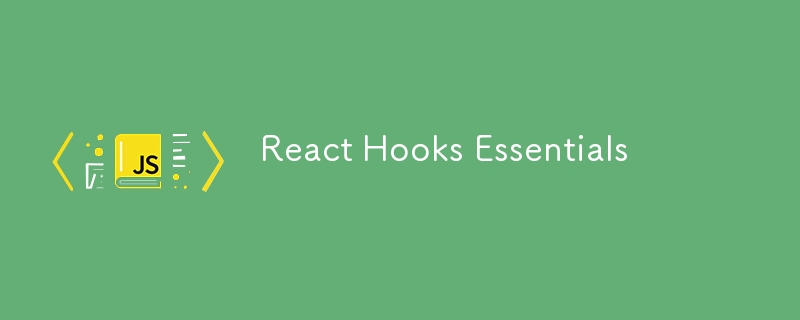

In React, Hooks are special functions that allow you to use state and other React features in functional components, without needing to convert them into class components. Introduced in React 16.8, hooks make it easier to reuse logic between components, handle state management, and manage side effects like data fetching or subscriptions, all within functional components.
The useState hook is fundamental for managing state in functional components. Instead of using class components with this.setState(), you can manage state seamlessly with this hook.
Syntax:
const [state, setState] = useState(initialState);
e.g.) In this example, it initializes count with a value of 0 and use the setCount function to update it when the button is clicked.
import React, { useState } from 'react';
function Counter() {
const [count, setCount] = useState(0);
return (
<div>
<p>Count: {count}</p>
<button onClick={() => setCount(count + 1)}>Increment</button>
</div>
);
}
The useEffect hook allows you to handle side effects in your components, like fetching data, updating the DOM, or subscribing to events.
Syntax:
useEffect(() => {
// Side effect logic
return () => {
// Cleanup
};
}, [dependencies]);
e.g.) In this example, useEffect fetches data from an API when the component mounts. The empty array [] as a second argument ensures the effect runs only once (like componentDidMount).
import React, { useState, useEffect } from 'react';
function DataFetcher() {
const [data, setData] = useState(null);
useEffect(() => {
fetch('https://api.example.com/data')
.then(response => response.json())
.then(data => setData(data));
}, []);
return (
<div>
{data ? <p>{data.title}</p> : <p>Loading...</p>}
</div>
);
}
When your state logic becomes more complex, consider using useReducer instead of useState. It’s similar to Redux but at the component level. You can use it to manage state transitions based on action types.
Syntax:
const [state, dispatch] = useReducer(reducer, initialState);
e.g.) In this example, useReducer handles two actions: increment and decrement. You use dispatch to trigger state updates based on these actions.
import React, { useReducer } from 'react';
const initialState = { count: 0 };
function reducer(state, action) {
switch (action.type) {
case 'increment':
return { count: state.count + 1 };
case 'decrement':
return { count: state.count - 1 };
default:
return state;
}
}
function Counter() {
const [state, dispatch] = useReducer(reducer, initialState);
return (
<div>
<p>Count: {state.count}</p>
<button onClick={() => dispatch({ type: 'increment' })}>+</button>
<button onClick={() => dispatch({ type: 'decrement' })}>-</button>
</div>
);
}
The useRef hook provides a way to directly access and manipulate DOM elements or store mutable values across renders without causing re-renders.
Syntax:
const myRef = useRef(initialValue);
e.g.) In this example, useRef allows direct access to the input filed, enabling to programmatically focus it when the button is clicked.
import React, { useRef } from 'react';
function InputFocus() {
const inputRef = useRef(null);
const handleFocus = () => {
inputRef.current.focus();
};
return (
<div>
<input ref={inputRef} type="text" />
<button onClick={handleFocus}>Focus Input</button>
</div>
);
}
One of the powerful aspects of hooks is that you can create your custom hooks to encapsulate and reuse logic across components. Custom hooks start with use and are just regular JavaScript functions that can use other hooks.
e.g.) In this example, the useFetch hook handles data fetching logic and can be reused in multiple components.
import { useState, useEffect } from 'react';
function useFetch(url) {
const [data, setData] = useState(null);
const [loading, setLoading] = useState(true);
useEffect(() => {
fetch(url)
.then(response => response.json())
.then(data => {
setData(data);
setLoading(false);
});
}, [url]);
return { data, loading };
}
function App() {
const { data, loading } = useFetch('https://api.example.com/data');
return <div>{loading ? <p>Loading...</p> : <p>{data.title}</p>}</div>;
}
The dispatch method can be used in combination with useReducer to create toggle states, which is helpful for handling components like modals, dropdowns, or toggling themes.
e.g.) The toggle action in the dispatch method switches the isVisible state between true and false, which in turn toggles the visibility of content.
import React, { useReducer } from 'react';
const initialState = { isVisible: false };
function reducer(state, action) {
switch (action.type) {
case 'toggle':
return { isVisible: !state.isVisible };
default:
return state;
}
}
function ToggleComponent() {
const [state, dispatch] = useReducer(reducer, initialState);
return (
<div>
<button onClick={() => dispatch({ type: 'toggle' })}>
{state.isVisible ? 'Hide' : 'Show'} Details
</button>
{state.isVisible && <p>Here are the details...</p>}
</div>
);
}
If you're interested in diving deeper into hooks or exploring useful custom hooks for your projects, I highly recommend checking out UseHooks.com. It’s a fantastic resource with tons of practical custom hooks that you can use and learn from.
The above is the detailed content of React Hooks Essentials. For more information, please follow other related articles on the PHP Chinese website!
 What are the common secondary developments in PHP?
What are the common secondary developments in PHP?
 C language variable naming
C language variable naming
 How to open php files on mobile phone
How to open php files on mobile phone
 Vue parent component calls the method of child component
Vue parent component calls the method of child component
 How to clean up your computer's C drive when it's full
How to clean up your computer's C drive when it's full
 There is no WLAN option in win11
There is no WLAN option in win11
 What are the new features of es6
What are the new features of es6
 What is a hidden element in jquery
What is a hidden element in jquery




